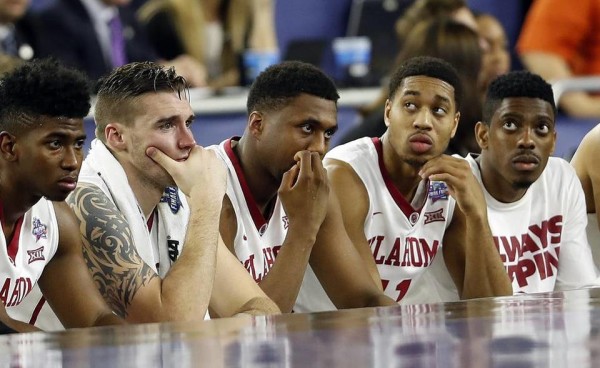What to Make of the Big 12’s NCAA Tournament Performance?
Posted by Chris Stone on April 8th, 2016Before this season, Villanova was the school that couldn’t get the job done in March. The Wildcats — seemingly always a high seed — had not made it past the round of 32 since 2009 (the last time they were in the Final Four), and for the entirety of this season, they were told that the only thing that mattered was what they accomplished in the season’s final three weeks. It was, as the Big East microsite’s Justin Kundrat put it, Villanova’s most burning question entering the NCAA Tournament. One month, six wins, and a historically dramatic three-pointer later, that criticism disappeared amid the confetti tumbling down to the NRG Stadium floor. Who now fills Villanova’s place as the perennial March underachiever? How about an entire conference — the Big 12 finds itself in a spot similar to where Jay Wright’s team was living. For any number of reasons, it has become the league that consistently delivers impressive regular season results and earns plenty of good to great seeds in the NCAA Tournament, only to generally flame out without making much of an impact on the event’s climactic final weekend.

Oklahoma was the Big 12’s final NCAA Tournament casualty this season. (David J. Phillip, AP)
A review of the past 12 NCAA Tournaments — dating back to Bill Self’s first of 12 straight regular season conference titles, and the source of so many “If Kansas wins it every year, how good can it really be?” arguments — illustrates the Big 12’s failings. The league has made the Final Four just three times in that span, with only two schools, Kansas and Oklahoma, navigating their way to the sport’s final weekend. That the Jayhawks’ close loss to Villanova in the Elite Eight this season was followed by a historic 44-point drubbing of the Sooners six days later did not inspire much confidence in the depth of the league. Digging a bit more deeply, conference teams playing their opening round games as the higher seed have compiled a rather uninspiring 37-17 record over that span, which includes six losses to lower seeded teams in the past two years. Put simply, the Big 12 hasn’t delivered at the time of year when everyone in the country is watching.
All of this data raises the question of whether the NCAA Tournament is the right measuring stick for determining overall conference quality. Sports fans across the country flock to televisions to watch March Madness because of its unpredictability. The “madness” is a huge part of what makes the Tournament so unique. It’s also what makes the event a potentially poor barometer for gauging the overall quality of an individual team or league. Off-nights happen — just ask Oklahoma. Unlikely shots occasionally bank in — just ask Texas. Individual basketball games are a bundle of randomness and variance. It’s why the NBA uses seven-game playoff series to determine its best team. Heck, even that doesn’t always work either (the 2007 Dallas Mavericks could attest to that).
Nonetheless, March is when the most fans are paying attention, and even though the league’s perception requires additional perspective, the Big 12 hasn’t gotten the job done when needed. There’s no question that the conference is filled with a number of talented teams: It has ranked either first or second in KenPom’s conference ratings in seven of the previous 12 years. Still, the league has its doubters, and deservedly so. All it has to do to shut them up next season is to perform well in March. Just ask Villanova.









































